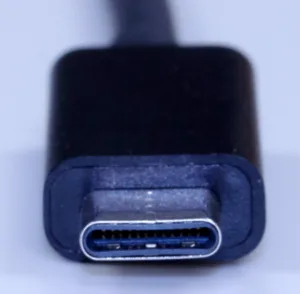The USB Implementors Forum (USB-IF) was in a hotel suite in the Venetian hotel and was promoting Type C connectivity. We met with Rahman Ismail who is employed by Intel, but works on the USB project.
USB Type C Image:USB Implementer’s ForumIsmail took us through the history of USB and especially the significant change with USB 3.0 (SuperSpeed) which was very significant as it changed the interface to be more symmetric (he described it as “Dual Simplex” in operation) which made the interface much better for storage applications than previous versions. He also explained how the “Alt” modes had come into existence when Type C was developed. Originally, the idea of the mode was just to allow companies to do proprietary things with the interface and that means that anybody can add a mode if they meet the negotiation conditions. We raised the question of an HDMI alt mode and Ismail confirmed that because the Alt mode is not really controlled, apart from the negotiation, it’s perfectly possible for HDMI to develop such a mode.
One of the reasons for allowing the mode was to ensure that the connector can be used for a long time and cope with new developments. Intel, Apple, Microsoft and Google were really looking for a connector that could be used for as long as ten years.
A big push this year in developing Type C is to ensure that the Power Delivery architecture (needed for charging above 15W) is widely supported and properly implemented and the group is developing a compliance programme around chargers. The USB-IF is also talking to regulators about getting regulations for charger connections to allow Type C to be used without the need for a Type C to micro-USB converter.
In the suite were a number of designs using Type C including a monitor that is capable of outputting the full power needed to charge a notebook. There was also a Quanta “storage dock” that can hold up to 8 Terabytes of data and is fast enough to allow editing of 4K video in RAW format. Of course, it uses Type C.
There is some work going on at the USB-IF to allow the elimination of the 3.5mm audio jack from mobile devices. Device makers want to eliminate the connector but USB audio has not been updated for a long time. The group is developing a simple and low cost mode for audio peripherals that can be implemented in even the most simple devices (without a full software stack). As well as getting rid of the 3.5mm jack, the new audio mode will allow easier support of features such as noise cancelling.
The group would like to see new developments in the USB A/V modes to support monitor and other display options (like DisplayLink). The real barrier to this is the operating system support that is needed. If it was implemented, multiple displays could simply be added by using a hub structure. However, the group is still keen to work on the idea that USB should be the only connection to a device.
Analyst Comment
There have been reports that there won’t be a 3.5mm audio jack on the next iPhone and that has caused some negative reaction from consumers. However, it makes quite a lot of sense to me, although it may take 10 or 15 years for the world to catch up!
USB has been doing a good job with Type C. After discussions at CES, we do expect HDMI to develop an “Alt” mode for Type C. Sadly, it is so far behind the curve on this topic that it is more likely to simply cause confusion than solve real world connectivity problems. (BR)

